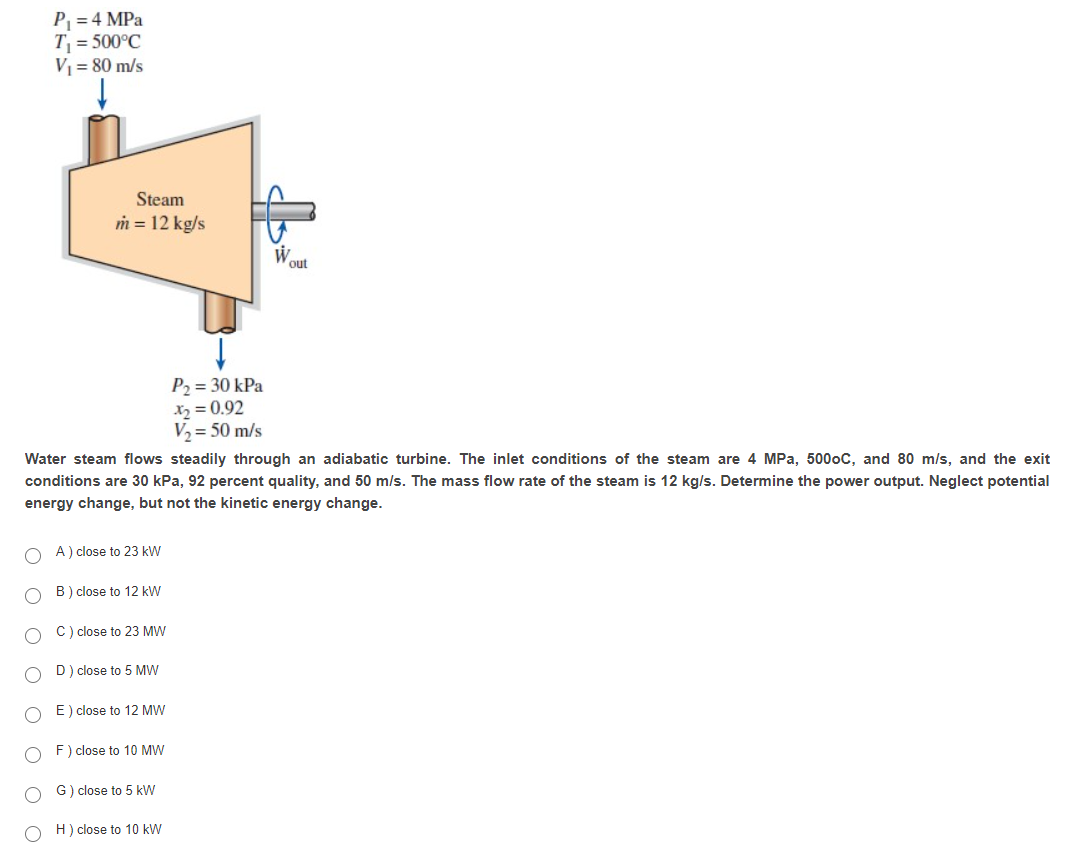Water steam flows steadily through an adiabatic turbine. The inlet conditions of the steam are 4 MPa, 500oC, and 80 m/s, and the exit conditions are 30 kPa, 92 percent quality, and 50 m/s. The mass flow rate of the steam is 12 kg/s. Determine the power output. Neglect potential energy change, but not the kinetic energy change. A ) close to 23 kW B ) close to 12 kW C ) close to 23 MW D ) close to 5 MW E ) close to 12 MW F ) close to 10 MW G ) close to 5 kW H ) close to 10 kW
Water steam flows steadily through an adiabatic turbine. The inlet conditions of the steam are 4 MPa, 500oC, and 80 m/s, and the exit conditions are 30 kPa, 92 percent quality, and 50 m/s. The mass flow rate of the steam is 12 kg/s. Determine the power output. Neglect potential energy change, but not the kinetic energy change. A ) close to 23 kW B ) close to 12 kW C ) close to 23 MW D ) close to 5 MW E ) close to 12 MW F ) close to 10 MW G ) close to 5 kW H ) close to 10 kW
Elements Of Electromagnetics
7th Edition
ISBN:9780190698614
Author:Sadiku, Matthew N. O.
Publisher:Sadiku, Matthew N. O.
ChapterMA: Math Assessment
Section: Chapter Questions
Problem 1.1MA
Related questions
Topic Video
Question
Water steam flows steadily through an adiabatic turbine. The inlet conditions of the steam are 4 MPa, 500oC, and 80 m/s, and the exit conditions are 30 kPa, 92 percent quality, and 50 m/s. The mass flow rate of the steam is 12 kg/s. Determine the power output. Neglect potential energy change, but not the kinetic energy change.
A ) close to 23 kW
B ) close to 12 kW
C ) close to 23 MW
D ) close to 5 MW
E ) close to 12 MW
F ) close to 10 MW
G ) close to 5 kW
H ) close to 10 kW

Transcribed Image Text:P = 4 MPa
T = 500°C
V1 = 80 m/s
Steam
m = 12 kg/s
W.
out
P2 = 30 kPa
X2 = 0.92
V2 = 50 m/s
Water steam flows steadily through an adiabatic turbine. The inlet conditions of the steam are 4 MPa, 5000C, and 80 m/s, and the exit
conditions are 30 kPa, 92 percent quality, and 50 m/s. The mass flow rate of the steam is 12 kg/s. Determine the power output. Neglect potential
energy change, but not the kinetic energy change.
A ) close to 23 kW
B) close to 12 kW
C) close to 23 MW
D) close to 5 MW
E) close to 12 MW
F) close to 10 MW
G) close to 5 kW
H) close to 10 kW
Expert Solution
This question has been solved!
Explore an expertly crafted, step-by-step solution for a thorough understanding of key concepts.
This is a popular solution!
Trending now
This is a popular solution!
Step by step
Solved in 2 steps with 3 images

Knowledge Booster
Learn more about
Need a deep-dive on the concept behind this application? Look no further. Learn more about this topic, mechanical-engineering and related others by exploring similar questions and additional content below.Recommended textbooks for you

Elements Of Electromagnetics
Mechanical Engineering
ISBN:
9780190698614
Author:
Sadiku, Matthew N. O.
Publisher:
Oxford University Press

Mechanics of Materials (10th Edition)
Mechanical Engineering
ISBN:
9780134319650
Author:
Russell C. Hibbeler
Publisher:
PEARSON

Thermodynamics: An Engineering Approach
Mechanical Engineering
ISBN:
9781259822674
Author:
Yunus A. Cengel Dr., Michael A. Boles
Publisher:
McGraw-Hill Education

Elements Of Electromagnetics
Mechanical Engineering
ISBN:
9780190698614
Author:
Sadiku, Matthew N. O.
Publisher:
Oxford University Press

Mechanics of Materials (10th Edition)
Mechanical Engineering
ISBN:
9780134319650
Author:
Russell C. Hibbeler
Publisher:
PEARSON

Thermodynamics: An Engineering Approach
Mechanical Engineering
ISBN:
9781259822674
Author:
Yunus A. Cengel Dr., Michael A. Boles
Publisher:
McGraw-Hill Education

Control Systems Engineering
Mechanical Engineering
ISBN:
9781118170519
Author:
Norman S. Nise
Publisher:
WILEY

Mechanics of Materials (MindTap Course List)
Mechanical Engineering
ISBN:
9781337093347
Author:
Barry J. Goodno, James M. Gere
Publisher:
Cengage Learning

Engineering Mechanics: Statics
Mechanical Engineering
ISBN:
9781118807330
Author:
James L. Meriam, L. G. Kraige, J. N. Bolton
Publisher:
WILEY